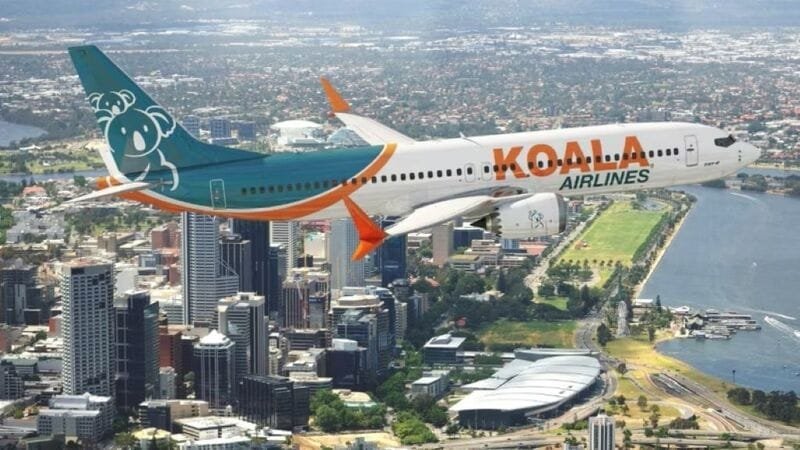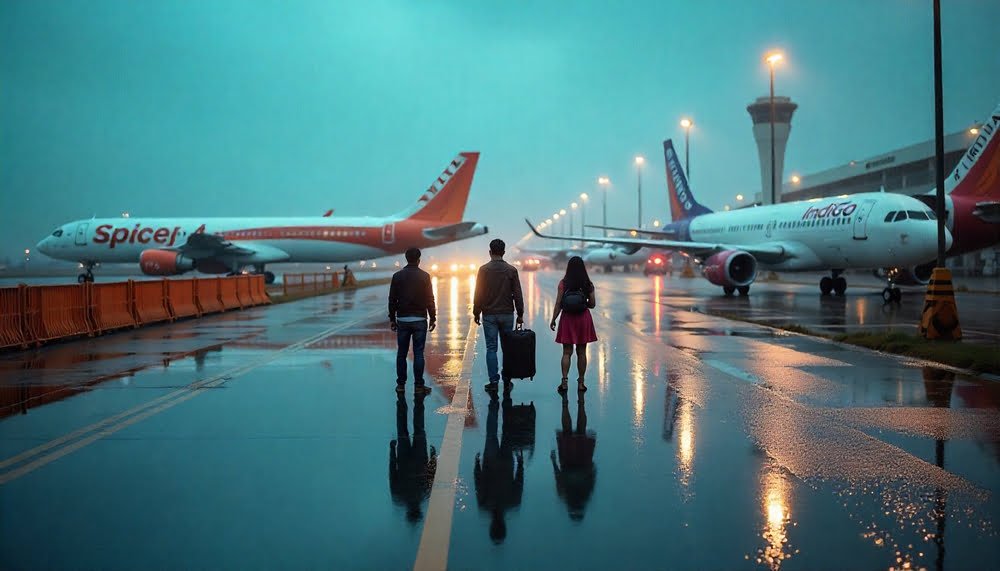Flight Buzz
Clean the Sky – Sustainable Domestic Flights

Koala Airlines is set to launch in late 2026, introducing a new model of domestic air travel focused on sustainability and regional connectivity. Rather than pursuing rapid expansion, the airline will concentrate on underserved routes across Australia, while embedding environmental responsibility into its operations from the outset.
The carrier plans to adopt fuel-efficient aircraft and implement practices aimed at lowering carbon emissions, supporting the aviation sector’s broader push toward decarbonization. Koala Airlines’ strategy reflects a shift away from aggressive market competition, favoring steady growth built on green innovation and thoughtful planning.
By targeting smaller markets and avoiding high-volume, high-emission routes, the airline positions itself as a low-impact alternative for eco-minded travellers. CEO Bill Astling emphasizes long-term resilience and ecological accountability, placing sustainability at the core of Koala Airlines’ vision for Australia’s aviation future.
Image Credit:
Australian Aviation
Flight Buzz
Turn Business Travel Into Free Flights With These 3 Cards

It’s always nice when your business gives something back — and what’s better than free travel?
A friend of mine owns a local restaurant and charges nearly all of his business purchases to the right credit card. Over time, he’s banked more than a million airline miles. And he uses them to fly him (and sometimes his close friends) to Hawaii a couple times a year.
If you want your business spending to earn travel rewards that actually feel rewarding, here are three standout credit cards worth checking out.
1. The Business Platinum Card® from American Express: Best for luxury travel
If you’re regularly flying for business and want VIP treatment, The Business Platinum Card® from American Express is a powerhouse. I held the personal version of this Platinum card for a few years and loved all the perks.
You’ll earn 5X points on flights and prepaid hotels booked on AmexTravel.com, and 1.5X points on purchases at US construction material & hardware suppliers, electronic goods retailers and software & cloud system providers, and shipping providers, as well as on each eligible purchase of $5,000 or more, up to $2 million of these purchases per calendar year (terms apply). This adds up fast if you’re spending on big business needs.
The real magic, though, is in how those Amex Membership Rewards points can be used. You can transfer them to 17 airline partners, which potentially gets higher redemption values (terms apply).
On top of that, it includes airline fee credits, lounge access, and hotel elite status (terms apply) — all perks that make business travel more comfortable. It’s not cheap, with a $695 annual fee (see rates and fees). But if you fly often, this business travel card earns its keep quickly.
2. The New United℠ Business Card: Best airline cobranded card
If you’re loyal to United (or even if you’re just looking for an easy way to earn airline miles on business spending) The New United℠ Business Card (see rates and fees) is a smart and affordable pick.
The welcome offer is a huge draw. You can earn 100,000 bonus miles after spending $5,000 in the first 3 months. That’s a huge head start toward free flights! And easily enough for a couple of domestic round trips, or a bigger redemption like snagging an international upgrade.
While you spend, you’ll also earn 2X miles on United® purchases, dining including eligible delivery services, at gas stations, office supply stores, and on local transit and commuting, plus 1X on all other purchases. The earning categories fit perfectly with typical business expenses, making it easy to build up miles just by running your business as usual.
Even with a modest $150 annual fee, you’ll get travel perks that punch above their weight. You’ll receive a free first checked bag on United flights, priority boarding, and two United Club lounge passes every year. Those benefits alone can easily offset the card’s cost, especially if you fly United a few times a year.
3. Sapphire Reserve for Business℠: Best for large spending
This newly launched Chase card is designed for business owners who want high-end travel perks and powerful rewards.
The Sapphire Reserve for Business℠ (see rates and fees) has more than $2,500 in annual value through travel credits, memberships, and other business benefits. Way more than enough to offset the $795 annual fee if you use the perks.
You’ll earn 8x points on Chase Travel℠ for airline tickets, hotels, including The Edit℠, car rentals, cruises, activities and tours, 5x total points on Lyft rides through 9/30/27, 4x points on flights & hotels booked direct, 3x points on social media & search engine advertising, and 1x on everything else.
Those points can go even further when you redeem through Chase’s new Points Boost offers, or transfer them to airline and hotel partners like United, Southwest, and Hyatt.
If your business already spends heavily on travel or advertising, this card can turn those expenses into serious travel rewards.
Which one suits your business?
The right card depends on how your business spends and how you like to travel.
- If you’re constantly flying and value lounge access, hotel upgrades, and transferable points, The Business Platinum Card® from American Express gets you a luxury experience with strong mileage potential.
- If you’re a regular United flyer that appreciates a modest annual fee, but several great travel perks, The New United℠ Business Card is a great fit. Take advantage of a free first checked bag on flights, priority boarding, and a huge welcome offer.
- For bigger spenders — especially on travel or ads — the Sapphire Reserve for Business℠ offers huge earning potential and over $2,500 in annual value. It’s ideal if you want high-end rewards and don’t mind a higher fee.
Whichever you choose, your everyday business expenses could be the key to your next free flight.
Flight Buzz
Emirates to ban use of power banks on flights

Emirates will not allow passengers to use power banks onboard aircraft from 1 October, in a change to its safety rules.
A power bank is a portable, rechargeable device used to provide power to electronic devices such as smart phones, tablets, laptops and cameras.
The airline will still allow passengers to carry a power bank that is under 100 watt hours, but it can’t be used to charge any personal devices on board. Charging a power bank using the aircraft’s power supply is also not permitted.
Emirates said all power banks accepted for transport must have capacity rating information available.
They must not be placed in the overhead stowage bin and must now be placed in the seat pocket or in a bag under the seat in front of the passenger.
Under an existing rule, power banks are not permitted in checked luggage.
The airline said: “There has been a significant growth in customers using power banks in recent years, resulting in an increasing number of lithium battery-related incidents onboard flights across the wider aviation industry.
“Emirates new regulations will significantly reduce risks associated with power banks by prohibiting their use while onboard the aircraft. Storing power banks in accessible locations within the cabin ensures that in the rare event of a fire, trained cabin crew can quickly respond and extinguish the fire.”
Flight Buzz
Air India, IndiGo, and SpiceJet Issue Urgent Travel Alert Leaving Over 100 Flights Delayed in Delhi as Heavy Rain and Traffic Woes Leave Thousands of Travelers Stranded

Published on
August 9, 2025 |
August 9, 2025, brought chaos to travels at Delhi’s Indira Gandhi International Airport as Air India, IndiGo, and SpiceJet fired off urgent travel alerts. Heavy monsoon rain flooded the city, waterlogging critical routes and snarling the roads, leading to the late departure of more than 100 flights. The torrents on the tarmac matched those in the city, and the slow-moving traffic leaving downtown only compounded the problem, leaving thousands of passengers stuck at check-in counters and in taxi queues. With meteorologists expecting the rain to persist, the backlog grew, and passengers learned that the day’s travel plan—already strained—was only the start of a longer ordeal in the capital’s weather.
On the morning of August 9, 2025, heavy rainfall in Delhi led to significant disruptions across the city, resulting in over 100 flight delays at Indira Gandhi International Airport. Passengers traveling on major airlines such as Air India, IndiGo, and SpiceJet found themselves stranded as severe weather caused chaos in the skies and on the roads. The capital’s already congested roads became impassable, exacerbating the situation as travelers struggled to reach the airport amidst waterlogging and traffic gridlocks.
As the storm showed no signs of abating, airlines issued urgent travel advisories, urging passengers to plan their journeys in advance, check flight statuses regularly, and be prepared for extended waiting times.
Flight Delays and Disruptions at Indira Gandhi International Airport
Flight operations at Indira Gandhi International Airport were severely affected by the heavy rain. According to flight-tracking data from Flightradar24, more than 135 flights to and from the airport were delayed by early morning. Of these, 120 departing flights and 15 incoming flights were directly impacted, with delays ranging from 30 minutes to several hours.
The poor weather conditions, coupled with low visibility caused by the downpour, were the main reasons for the delays. Additionally, the waterlogged runways and flooded areas around the airport further complicated operations, preventing the timely departure and arrival of flights.
As a result, passengers faced long waits in terminals, many of them unsure of when they would be able to board their flights. The delays also had a ripple effect, extending throughout the day and affecting flights scheduled in the afternoon and evening.
Airlines Issue Travel Advisories Amid Disruptions
To mitigate the impact of the adverse weather, airlines such as Air India, IndiGo, and SpiceJet took proactive measures by issuing travel advisories to their passengers. The advisories were aimed at helping travelers navigate through the chaos and minimize their frustration.
- IndiGo, one of the largest low-cost carriers in India, advised its passengers to arrive at the airport well in advance to account for both weather-related delays and heavy traffic. The airline also recommended exploring alternate routes to the airport to avoid getting caught in traffic congestion.
- Air India echoed similar advice, urging passengers to check their flight statuses frequently and to allow extra time for their travel. They emphasized the importance of arriving early at the airport due to the slow-moving traffic caused by the rainfall.
- SpiceJet, which operates several domestic and international routes from Delhi, also issued warnings regarding possible delays. The airline advised passengers to remain patient and stay updated with real-time flight information, especially as the weather conditions continued to fluctuate.
These travel advisories were designed to help passengers manage their time more effectively and reduce the overall impact of the delays. However, despite these efforts, the ongoing weather conditions made it difficult to provide exact timelines for the resumption of normal flight operations.
The Impact of Severe Weather on Ground Transportation
In addition to the flight delays, the heavy rainfall caused major disruptions to ground transportation in Delhi. Several areas, including Mathura Road, Panchkuian Marg, and Connaught Place, were severely waterlogged, leading to massive traffic jams. Commuters trying to reach the airport were faced with slow-moving vehicles and increased travel times.
The traffic congestion was further exacerbated by the volume of vehicles trying to navigate through flooded streets, as well as the lack of clear drainage systems in some areas. As a result, many passengers missed their flights or were unable to reach the airport in time for check-in.
Local authorities worked to clear the roads, but the sheer volume of water on the streets made it challenging to restore normal conditions. As the storm persisted, the situation only worsened, with many roads remaining submerged under several inches of water for hours.
Public Transportation: A Viable Alternative
In light of the traffic chaos, Delhi Airport authorities recommended the use of public transportation, particularly the Delhi Metro, as a more efficient means of reaching the airport. The Delhi Metro, which connects various parts of the city to the airport, was suggested as an alternative to private vehicles, especially since the metro network was largely unaffected by the rain.
However, even the metro system saw some delays, although not to the extent of the road network. Passengers were advised to check the metro’s real-time updates to plan their journeys accordingly. Using the metro was particularly helpful for those who were trying to avoid the worst of the flooding on the roads.
Despite these suggestions, many travelers still faced long waits and uncertainties as they navigated through the disruptions caused by the severe weather.
Weather Forecast and Outlook
According to the India Meteorological Department (IMD), the heavy rain and thunderstorms that affected Delhi were expected to continue throughout the day. A red alert had been issued for the city, with further downpours anticipated in the afternoon and evening.
The IMD also predicted that these adverse weather conditions could extend into the next few days, which means travelers heading to Delhi may continue to face delays and disruptions over the weekend. The ongoing rain, coupled with the forecast of more storms, has left the city’s transportation systems vulnerable to further interruptions.
Authorities and airlines have stressed the importance of staying updated on the weather and flight statuses, as conditions could change rapidly throughout the day.
Advice for Passengers
Given the ongoing disruptions, travelers were advised to take the following precautions:
- Check Flight Status Frequently: With continuous changes in flight schedules, it is essential for passengers to check their flight statuses regularly via the airline’s website or app to stay informed about any delays or cancellations.
- Arrive Early: Due to slow-moving traffic and the possibility of further delays, passengers should arrive at the airport well in advance of their flight time. This will help account for any unforeseen circumstances and ensure they do not miss their flights.
- Consider Public Transportation: Whenever possible, passengers should use the Delhi Metro or other forms of public transport to avoid the traffic gridlocks caused by the heavy rain.
- Stay Patient and Prepared: Given the ongoing disruptions, it is important for travelers to remain patient and flexible with their plans. Flight delays are likely to continue, so passengers should be prepared for extended waiting times at the airport.
On August 9, 2025, heavy rainfall and severe traffic jams hit Delhi hard. The rainfall brought over 100 flight delays at Indira Gandhi International Airport, according to urgent alerts from Air India, IndiGo, and SpiceJet. Thousands of travelers were left waiting as waterlogged runways and flooded streets caused huge backups.
Rainfall worsened through the day. Passengers were told to check flight updates and keep plans flexible. The storms worsened not only air travel but ground transport too, keeping terminal roads and rail links choked with delays. Many missed onward connections, creating a ripple effect felt throughout the metro.
Air India, IndiGo, and SpiceJet tried to keep lines of communication open. They sent real-time updates and rescheduling links through apps and social media. Yet, with another storm system predicted to develop, travelers were urged to be patient and avoid arriving too early at the airport when roads were already clogged.
Delhi officials and airline teams continued to monitor weather radar and water levels. Plans included deploying extra buses and staff to ease the crush in the terminals. Passengers were reminded that with conditions still changing, the best approach was to keep checking flight info and allow extra time to get to their gate.
-

 Brand Stories3 weeks ago
Brand Stories3 weeks agoBloom Hotels: A Modern Vision of Hospitality Redefining Travel
-

 Brand Stories2 weeks ago
Brand Stories2 weeks agoCheQin.ai sets a new standard for hotel booking with its AI capabilities: empowering travellers to bargain, choose the best, and book with clarity.
-

 Destinations & Things To Do3 weeks ago
Destinations & Things To Do3 weeks agoUntouched Destinations: Stunning Hidden Gems You Must Visit
-

 Destinations & Things To Do2 weeks ago
Destinations & Things To Do2 weeks agoThis Hidden Beach in India Glows at Night-But Only in One Secret Season
-

 AI in Travel3 weeks ago
AI in Travel3 weeks agoAI Travel Revolution: Must-Have Guide to the Best Experience
-

 Brand Stories1 month ago
Brand Stories1 month agoVoice AI Startup ElevenLabs Plans to Add Hubs Around the World
-

 Brand Stories4 weeks ago
Brand Stories4 weeks agoHow Elon Musk’s rogue Grok chatbot became a cautionary AI tale
-

 Brand Stories2 weeks ago
Brand Stories2 weeks agoContactless Hospitality: Why Remote Management Technology Is Key to Seamless Guest Experiences
-

 Asia Travel Pulse1 month ago
Asia Travel Pulse1 month agoLooking For Adventure In Asia? Here Are 7 Epic Destinations You Need To Experience At Least Once – Zee News
-

 AI in Travel1 month ago
AI in Travel1 month ago‘Will AI take my job?’ A trip to a Beijing fortune-telling bar to see what lies ahead | China

You must be logged in to post a comment Login